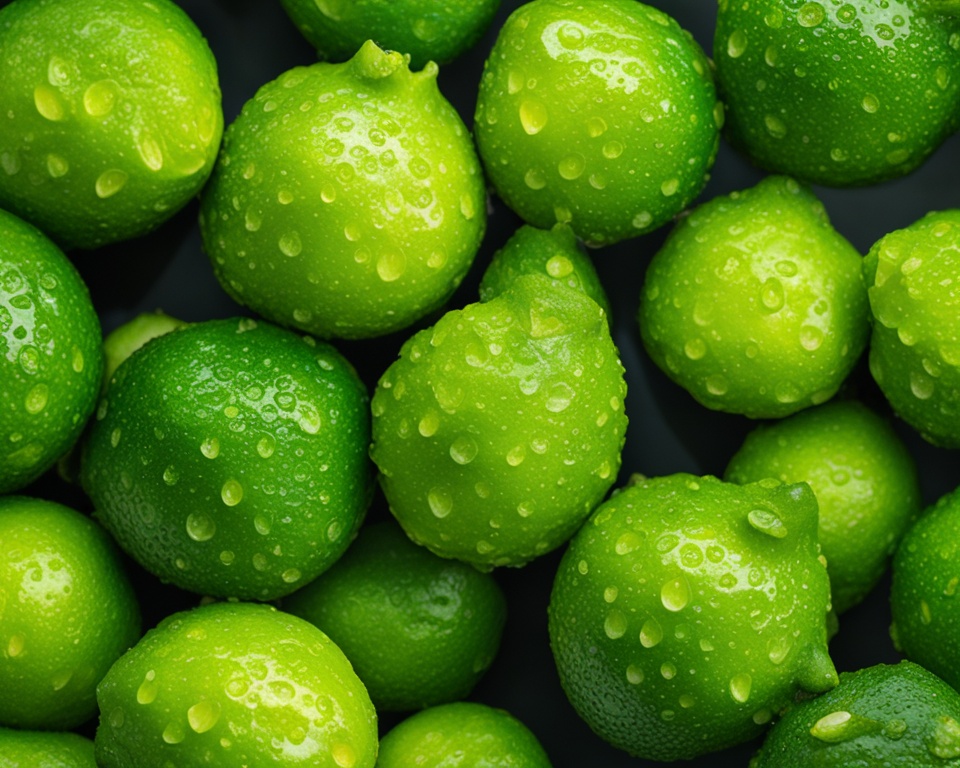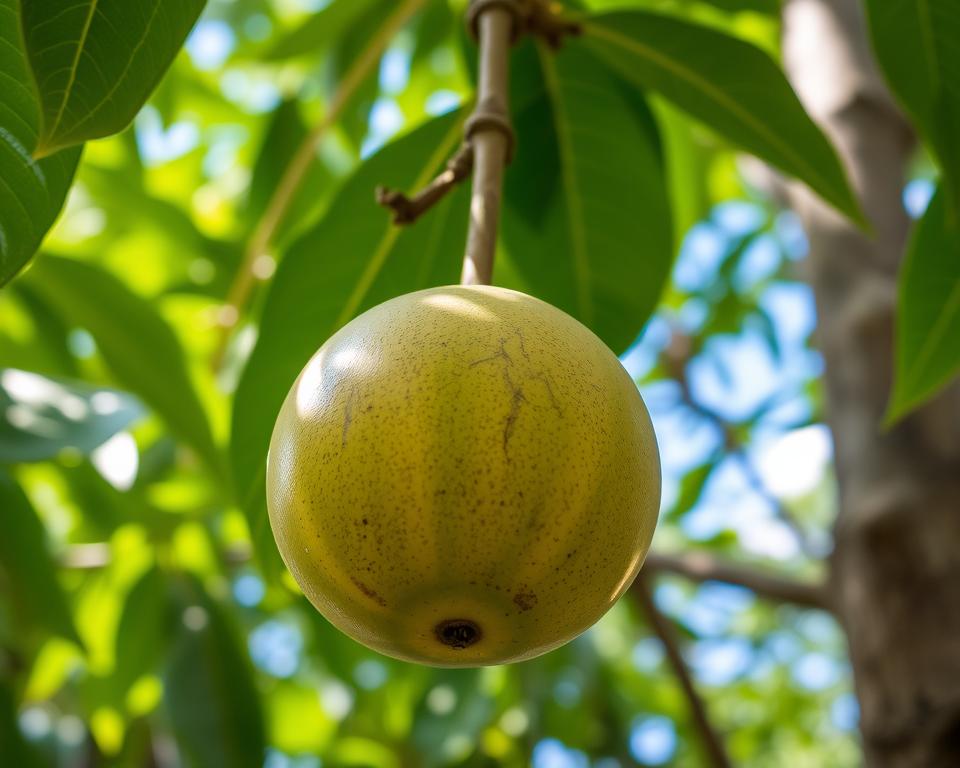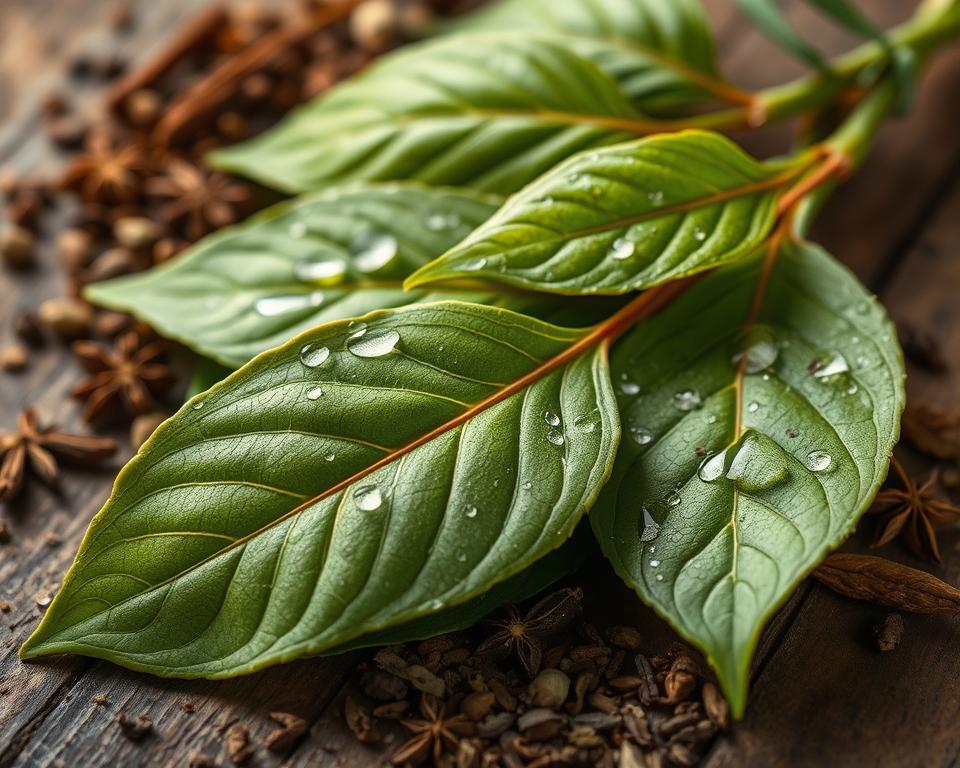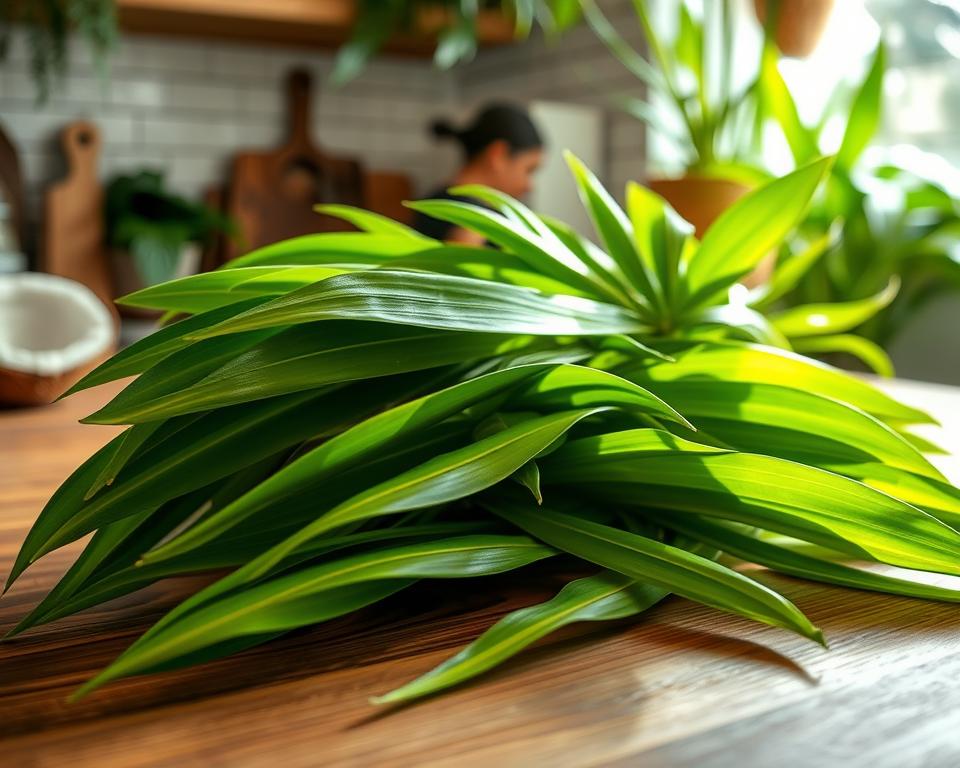Join us on a journey into the world of the Kaffir lime, a key ingredient in Asian cooking. It’s known for its unique smell and many uses. We’ll cover its origins, how it’s used in cooking, and why it’s so special. This article is for anyone who loves food and wants to learn more about this exotic citrus fruit.
Read interesting things at : tosawakan
Key Takeaways
- Kaffir lime is a unique citrus fruit with a distinctive flavor and aroma, prized in Asian cuisines.
- The leaves and zest of the Kaffir lime are widely used to impart a unique fragrance and taste to various dishes.
- Kaffir lime can be used in a variety of ways, from marinades and dressings to sauces and garnishes.
- Growing your own Kaffir lime tree can be a rewarding experience, with specific climate and soil requirements.
- Kaffir lime offers potential health benefits, including antioxidant properties and antimicrobial effects.
Introduction to the Kaffir Lime
The kaffir lime, also known as the makrut lime or Thai lime, is a special citrus fruit. It’s loved in Asian cooking. This plant stands out with its unique double-leaf look. It has a deep history and an interesting story.
Origins and Botanical Classification
The kaffir lime comes from the tropical parts of Southeast Asia. Countries like Thailand, Indonesia, and Malaysia are its home. It’s classified as Citrus hystrix and is part of the Rutaceae family. This family also includes oranges, lemons, and limes.
Distinctive Appearance and Aroma
The kaffir lime is known for its unique, bumpy skin and double-leaf leaves. These leaves have a strong scent. The fruit is small, about the size of a golf ball, and turns yellow when ripe.
The smell of the kaffir lime is a mix of citrus, herbs, and flowers. This makes it a favorite in many recipes, from meals to drinks.
“The kaffir lime is a unique and versatile ingredient that has captivated the culinary world with its vibrant flavors and aroma.”
Culinary Uses of Kaffir Lime
Kaffir lime is known for its unique smell and strong taste. It’s a key ingredient in many Asian dishes. People in Thailand, Indonesia, and Malaysia love using it to make their food more interesting.
Kaffir lime is often used in curries. Its leaves and zest make the curry taste special and fragrant. Whether it’s a creamy Thai red curry or a spicy Indonesian rendang, kaffir lime is a must-have.
Kaffir lime is also great for marinades and dipping sauces. Its zest and juice add a tangy taste to meat, seafood, or tofu marinades. The leaves add a subtle bitterness that balances sweet and salty flavors.
| Culinary Application | Kaffir Lime Contribution |
|---|---|
| Curries | Adds depth and complexity to the flavor profile |
| Marinades and Dipping Sauces | Imparts a tangy, refreshing, and balancing note |
| Stir-Fries | Enhances the aromatic and citrusy qualities of the dish |
| Rice Dishes | Complements the nutty, earthy flavors of rice |
In stir-fries, kaffir lime leaves and zest make the dish smell and taste better. In rice dishes, they match well with the nutty and earthy flavors of the grain.
Kaffir lime is versatile and adds a special touch to many Asian dishes. It’s a favorite among chefs and home cooks for its unique flavor.
Kaffir Lime Leaves: A Versatile Ingredient
Kaffir lime leaves are a key ingredient in Thai cooking. They bring a unique citrus smell and taste to many dishes. These leaves are a big part of what makes Thai food so special.
Thai Cuisine and Kaffir Lime Leaves
In Thai cooking, kaffir lime leaves are used in curries, soups, stir-fries, and marinades. They add a special, slightly bitter and earthy flavor. This flavor goes well with the hot, sour, sweet, and salty tastes of Thai food.
Kaffir lime leaves are often mixed with lemongrass, galangal, and other herbs. This mix creates the unique taste of Thai dishes.
Other Global Cuisines Embracing Kaffir Lime Leaves
Kaffir lime leaves are not just for Thai food. They are also used in many other cuisines around the world. In Indonesian and Malaysian cooking, they’re in curries and rendang. In Cambodian and Lao food, they add depth to soups and stews.
In Indian cuisine, kaffir lime leaves are sometimes added to curries and chutneys. Even in Western kitchens, they’re being used in marinades, sauces, and baked goods. This shows how versatile kaffir lime leaves are in different types of cooking.
| Cuisine | Kaffir Lime Leaf Usage |
|---|---|
| Thai | Curries, soups, stir-fries, marinades |
| Indonesian/Malaysian | Curries, rendang |
| Cambodian/Lao | Soups, stews |
| Indian | Curries, chutneys |
| Western | Marinades, sauces, baked goods |
Kaffir lime leaves are a versatile ingredient in many cuisines. They can improve a wide range of dishes, both traditional and modern.
Zest and Juice: Enhancing Flavors
The kaffir lime zest and juice are a powerful duo for boosting dish flavors. They can transform a variety of dishes, from desserts to main courses. This dynamic pair brings a fresh twist to your cooking.
Lime zest is the outer layer of the kaffir lime fruit. It’s full of flavor. Adding a bit of zest can make your dishes smell and taste better. It’s perfect for cocktails or desserts.
Lime juice from the kaffir lime is both tangy and aromatic. It can balance flavors and add a unique tropical taste. Use it in marinades, dressings, sauces, or sorbets to explore its versatility.
| Ingredient | Usage | Benefits |
|---|---|---|
| Kaffir Lime Zest |
|
|
| Kaffir Lime Juice |
|
|
Use kaffir lime zest and juice to take your cooking to the next level. These ingredients add an exotic touch to your dishes. Try them out to see how they can elevate your meals.
Dried Kaffir Lime: A Convenient Option
When you can’t find fresh dried kaffir lime, the dried version is a great substitute. It keeps the unique smell and taste of fresh kaffir lime. This makes it a great addition to many dishes.
Dried dried kaffir lime is easy to get and keeps well for a long time. This is great because fresh kaffir lime might be hard to find in some places. So, you always have this special citrus flavor on hand.
Incorporating Dried Kaffir Lime into Your Cooking
You can use dried dried kaffir lime in many ways to make your food taste better. Here are some ideas:
- Add a teaspoon or two of dried dried kaffir lime to soups, stews, and curries for a unique flavor.
- Put dried dried lime in marinades or rubs for meats, fish, or tofu to give them a special citrus taste.
- Use dried dried kaffir lime in baking, like in breads, pastries, or desserts, for a subtle citrus twist.
- Sprinkle dried dried lime over rice dishes or roasted vegetables for a burst of flavor.
| Dried Kaffir Lime | Fresh Kaffir Lime |
|---|---|
| Convenient for long-term storage and availability | Requires access to fresh local sources |
| Retains much of the distinctive aroma and flavor | Offers the most vibrant and intense flavor profile |
| Easier to incorporate into a wide range of dishes | May be more delicate and require more careful handling |
Using dried dried kaffir lime lets cooks at home and in restaurants try new recipes. It brings the unique taste of this citrus to their dishes.
Growing Your Own Kaffir Lime Tree
If you love Southeast Asian flavors, growing your own kaffir lime tree is a great idea. This citrus plant brings unique zest and fragrance to your cooking. It also makes your garden feel exotic.
Climate and Soil Requirements
The kaffir lime tree does well in warm, humid places. It can handle mild frosts but not cold for a long time. It likes soil that drains well and is a bit acidic, rich in organic stuff. Adding compost or peat moss can make the soil perfect for it.
Maintenance and Pruning Tips
- Water the tree often, but not too much, during the growing season.
- Prune it regularly to keep its shape and promote new growth. Cut off any dead or damaged branches.
- Feed the tree with a balanced, slow-release fertilizer for healthy growth and lots of leaves.
- Keep the kaffir lime tree out of direct sunlight during the hottest part of the day to prevent leaf damage.
By following these tips, you can have a healthy kaffir lime tree. It will give you lots of tasty leaves, zest, and juice for your cooking.
Kaffir Lime’s Health Benefits
The kaffir lime is more than just a pretty face. It’s packed with health benefits that are exciting to learn about. This citrus fruit is full of antioxidants, vitamins, and compounds that boost your health.
The kaffir lime is known for its strong antioxidant content. Its leaves and fruit are loaded with flavonoids and phenols. These substances fight off free radicals and shield cells from damage. This could help keep your immune system strong and lower the risk of chronic illnesses.
Also, kaffir lime is great for your digestion. Its leaves and juice boost digestive enzymes. This can make digestion smoother and might ease problems like bloating, constipation, and indigestion.
- High in antioxidants to support immune health
- May aid digestion and alleviate gastrointestinal issues
- Contains vitamins and minerals that contribute to overall wellbeing
Even though more studies are needed, the health benefits of kaffir lime are promising. It’s a smart choice for those looking to eat more nutrient-rich foods. Adding it to your meals or drinks can make your diet healthier and more interesting.
Substitutes for Kaffir Lime
When you can’t find fresh or dried kaffir lime, there are other options. These kaffir lime substitutes and lime substitutes can give you similar tastes in your cooking.
Lime Zest and Juice
Using the zest and juice of regular or key limes can work instead of kaffir lime. They won’t taste exactly the same, but they can still add a citrusy flavor to many dishes.
Lemon Grass
Lemongrass can also stand in for kaffir lime. It adds a herbaceous and slightly lemony taste to curries, soups, and marinades.
Makrut Lime Leaves
If you can find makrut lime leaves, they’re a great swap for kaffir lime leaves. They taste very similar and can be used in most recipes.
| Substitute | Flavor Profile | Best For |
|---|---|---|
| Lime Zest and Juice | Citrusy notes | Curries, marinades, dressings |
| Lemongrass | Herbaceous, lemony | Soups, stir-fries, curries |
| Makrut Lime Leaves | Identical to kaffir lime | Any recipe calling for kaffir lime leaves |
When you’re substituting ingredients, remember to adjust the amount and timing. This will help you get the flavor you want. Try different amounts and taste as you go to perfect your dish.
Storing and Preserving Kaffir Lime
Keeping the fresh taste and smell of kaffir lime is crucial for its best use in cooking. If you have a lot of limes or want to keep them fresh longer, learning how to store and preserve them is important.
Freezing is a great way to store kaffir lime. Put the leaves or fruit in a container or bag that seals well, and get as much air out as you can. This keeps the kaffir lime fresh for months, making it easy to use all year.
If you want something easier, dried kaffir lime leaves are a good choice. Drying the leaves makes them last longer and keeps their unique smell and taste. Just spread the leaves on a baking sheet and dry them in a low oven or a dehydrator until they’re dry and hard.
You can also make a concentrated paste or puree with kaffir lime. Blend the leaves or zest with a bit of water or oil. This makes a handy ingredient that keeps well in the fridge or freezer.
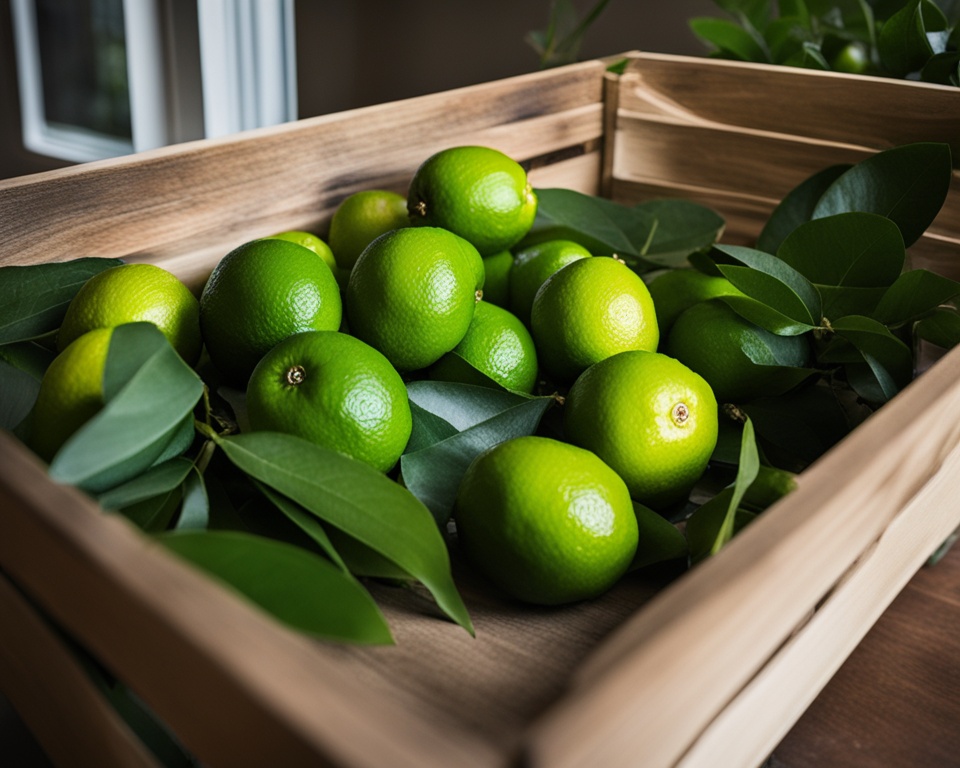
Whatever method you pick for storing or preserving kaffir lime, keep it away from air, light, and moisture. This keeps it fresh and potent. With the right methods, you can enjoy kaffir lime’s bright, citrusy taste all year.
Kaffir Lime in Beverages and Cocktails
The unique and vibrant flavor of kaffir lime makes it a top choice for drinks and cocktails. Its zesty taste and soothing aroma can make a wide range of drinks better. It adds a refreshing twist to teas, smoothies, and signature cocktails.
Kaffir lime leaves are a popular ingredient in drinks. You can steep them in hot water to make a fragrant tea. Or blend them into smoothies and juices for a burst of flavor. These leaves can also be muddled in cocktails, adding a unique citrus taste that goes well with many spirits and mixers.
The zest and juice of kaffir lime can also be used in cocktails. Bartenders often use the zest as a garnish. The juice can be made into syrups or added directly to drinks. Kaffir lime is versatile and can be added to many cocktail recipes, from gin and tonics to tropical rum drinks.
“The complex and fragrant profile of kaffir lime makes it a game-changer in the world of beverages and cocktails. Its ability to add a touch of the exotic and a burst of citrus is unparalleled.”
If you want to improve your homemade kaffir lime tea or make a signature cocktail, the options are endless. Embrace the unique flavors of kaffir lime and let it take your taste buds on a culinary journey.
Kaffir Lime: A Taste of the Exotic
The kaffir lime is a key player in the world of food. It’s a exotic ingredient that chefs and food lovers can’t get enough of. This citrus fruit is known for its unique look and smell. It’s a must-have in many culinary traditions around the globe.
This fruit takes your taste buds on a wild ride. Its smell is a mix of lemon and lime, drawing you in. It adds a special touch to dishes like Thai curries and Southeast Asian soups. The kaffir lime can make even simple ingredients shine.
The kaffir lime also looks as good as it tastes. Its bumpy skin and deep green color add an exotic touch to any dish. When you slice or zest it, the fruit’s look can change a meal completely, adding mystery to your plate.
| Flavor Profile | Culinary Applications |
|---|---|
| Sharp, pungent aroma with notes of lemon and lime |
|
If you want to try new flavors, the kaffir lime is a great choice. It’s versatile and adds something special to dishes. It’s perfect for cooks who love to explore new tastes and take their senses on an exotic journey.
“The kaffir lime is a true chameleon of the culinary world, capable of transforming even the simplest dish into a symphony of flavors.”
Recipes Featuring Kaffir Lime
Kaffir lime is a versatile citrus fruit that can make many dishes special. It adds a unique flavor to everything from Thai dishes to cocktails. This exotic ingredient can turn simple recipes into amazing meals.
Check out these kaffir lime recipes to add this citrus to your cooking:
Kaffir Lime Chicken Skewers
Marinate chicken with kaffir lime leaves, lemongrass, garlic, and fish sauce for a Thai dish full of zesty flavors. Grill the skewers until they’re perfect. Serve with a kaffir lime dipping sauce.
Kaffir Lime and Coconut Shrimp
Cook shrimp in coconut milk with kaffir lime leaves for a dish that’s sweet, sour, and savory. It’s perfect for a Thai-themed meal.
| Recipe | Ingredients | Preparation Time |
|---|---|---|
| Kaffir Lime Shortbread Cookies | Butter, sugar, flour, kaffir lime zest | 1 hour |
| Kaffir Lime and Lemongrass Iced Tea | Black tea, kaffir lime leaves, lemongrass, honey | 30 minutes |
| Kaffir Lime Panna Cotta | Cream, milk, sugar, kaffir lime leaves, gelatin | 2 hours |
Discover the many kaffir lime recipes and let this citrus inspire your cooking. Use its unique flavors and aromas to make your dishes stand out with recipe ideas.
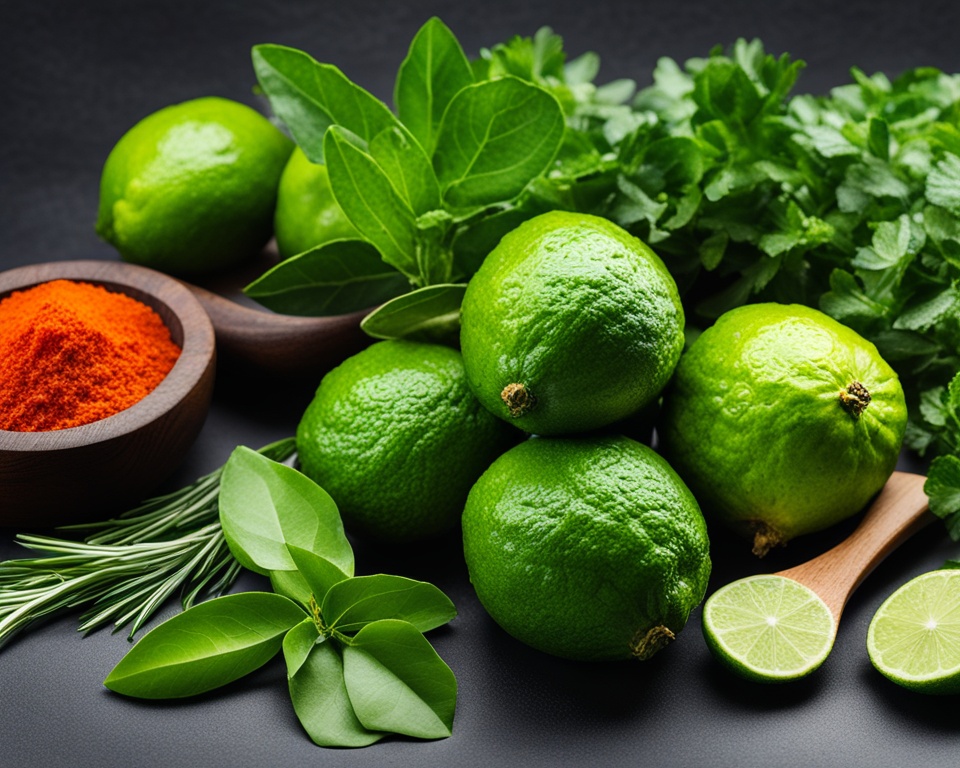
Kaffir Lime: A Versatile Ingredient
The kaffir lime is a true gem in the kitchen, known for its unique aroma and vibrant flavors. It goes beyond Thai cuisine, adding depth to many dishes. From savory to sweet, it brings a special touch to any meal.
It’s famous in Thai curries and soups, but its uses go far beyond that. The leaves, zest, and juice of the kaffir lime can make any dish better. They add a bright, fragrant taste to seafood, poultry, and even desserts.
Whether you’re making a Thai curry, adding zest to cocktails, or using the leaves in a marinade, the kaffir lime is versatile. It can change and improve many dishes, making it essential for anyone who loves to cook.






